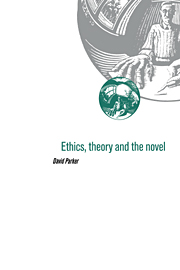Book contents
- Frontmatter
- Contents
- Acknowledgements
- Part I THE ETHICAL UNCONSCIOUS
- Chapter 1 Evaluative discourse: the return of the repressed
- Chapter 2 A new turn toward the ethical
- Chapter 3 The judgmental unconscious
- Chapter 4 The libidinal unconscious
- Chapter 5 Dynamic interrelatedness: or, the novel walking away with the nail
- Part II SOCIAL BEINGS AND INNOCENTS
- Part III TOWARDS A NEW EVALUATIVE DISCOURSE
- Notes
- Bibliography
- Index
Chapter 5 - Dynamic interrelatedness: or, the novel walking away with the nail
Published online by Cambridge University Press: 05 November 2011
- Frontmatter
- Contents
- Acknowledgements
- Part I THE ETHICAL UNCONSCIOUS
- Chapter 1 Evaluative discourse: the return of the repressed
- Chapter 2 A new turn toward the ethical
- Chapter 3 The judgmental unconscious
- Chapter 4 The libidinal unconscious
- Chapter 5 Dynamic interrelatedness: or, the novel walking away with the nail
- Part II SOCIAL BEINGS AND INNOCENTS
- Part III TOWARDS A NEW EVALUATIVE DISCOURSE
- Notes
- Bibliography
- Index
Summary
In their need to forget what they cannot, without some degree of psychic distortion, forget, Anna Karenina and Koznyshev are unexpectedly alike. It is this which links the seemingly unlinkable scene of Anna's death (7,31) with the one narrating Koznyshev's literary failure, which immediately follows it (8,1). On the other hand, what they are struggling to forget is so different as hardly to bear comparison. In Anna's case, it is her son, her husband, and that social, spiritual, and moral life which have become impossible in her life with Vronsky. The tragic core of Anna's case is that, in following the path that she individually had to follow, she had to violate the ‘One Law’ of Judeo-Christianity which demands that we treat all others as morally equivalent to, and continuous with, ourselves. Had that law held sway for her, she could not have left Karenin. Koznyshev, as I have argued, fails before the moral imperative Anna does follow. Anna and Koznyshev might be taken schematically to illustrate failure before two different sorts of moral demands that, as the novel suggests, are incommensurable and only sometimes reconcilable.
On another level, these two different sorts of moral demand have their counterparts in the ethical beliefs, values, and languages of novelists themselves. As Charles Taylor argues, there is a necessary tension between the two sorts: ‘we are and cannot but be on both sides of the great intramural moral disputes’ of our culture.
- Type
- Chapter
- Information
- Ethics, Theory and the Novel , pp. 57 - 66Publisher: Cambridge University PressPrint publication year: 1994



